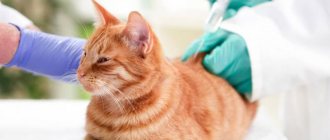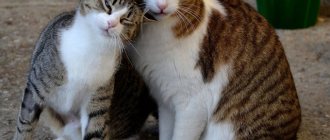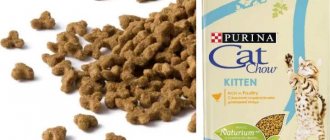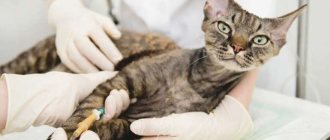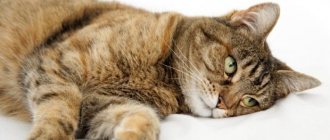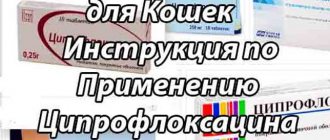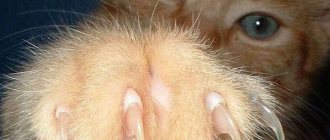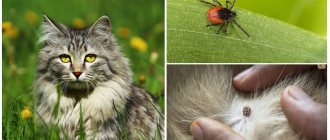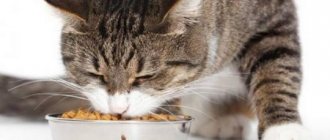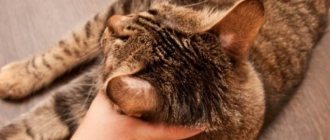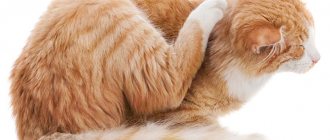The use of anesthesia during surgery is a very exciting moment for owners of furry pets. Even with a favorable outcome, the operated animal will require proper care to facilitate a safe recovery. Knowing how cats recover from anesthesia after castration or sterilization, you can easily provide your pet with the necessary help, eliminating the development of serious complications.
Using anesthesia for cats
Caring owners are interested not only in how long it takes for cats to recover from anesthesia after sterilization, but also in the possible danger of the event. Unpleasant consequences can be avoided only if all contraindications are strictly observed.
How harmful is it
The drugs used in animal anesthesiology have a mild and safe effect. All dosages are selected individually based on the analysis of the mustachioed patient. Before surgery, the veterinarian must check the functioning of the heart to assess possible risks.
Please note that there is always a possibility of death. A doctor’s denial of this fact is a lie that leaves an imprint on his competence. The main task of the anesthesiologist and veterinary therapist is to minimize risks. By taking into account contraindications and choosing the right drug and dose, the likelihood of complications is close to zero.
Contraindications
After anesthesia, the cat’s body is greatly weakened, so additional aggravating factors are detrimental to it. Contraindications for surgical intervention include:
- diseases of the respiratory system and heart;
- periods of estrus, gestation and feeding of offspring;
- age more than 10 years;
- pathologies of the genitourinary system in chronic form and viral infections in acute form.
Despite these limitations, they can be neglected. This is acceptable if the animal’s life is at risk and other methods of treatment do not help it - then the risk of surgery fades into the background.
Veterinarians do not recommend using anesthesia more than once a year - if time is of the essence, it is better to postpone the operation or use alternative treatment methods.
Inhalation anesthesia for rodents and ferrets
The most delicate pets at Alisavet are given inhalation anesthesia
All three stages of creating gas anesthesia are carried out in these animals. However, there are small peculiarities here.
Inhalation anesthesia for small rodents is also carried out after premedication. In hamsters and rats, a tube is not inserted into the trachea, so the gas mixture enters through a special mask.
Ferrets and large rodents (guinea pigs, rabbits) are first given premedication, after which an intravenous catheter is installed, and then a gas mixture is also supplied using special masks.
03/09/18 Anesthesia for rabbits. Inhalation (gas) anesthesia
How to prepare an animal for surgery
Most complications that appear in the postoperative period are associated with a sharp drop in immunity. To preserve the body's defenses, it is important to prevent any pathological conditions that could harm the pet.
Most often, operated patients become infected with worms and viruses, so treatment against parasites and vaccination are prerequisites for operations under general anesthesia. An anthelmintic is given 1.5 weeks before the procedure, and the vaccine is administered no later than a month.
If vaccination is missed according to schedule, then a serum injection is used. It gives similar results in a shorter time - within 2 weeks.
A couple of days before the operation, the blood and urine of the future patient are checked for possible deviations. To calculate the volume of anesthesia, indicators obtained on ultrasound and x-ray of the respiratory and cardiac organs are taken into account.
Half a day before the start of the operation, the cat should not be fed, and 3 hours before the operation, the cat should not be given water. The absence of solid and liquid food prevents the occurrence of nausea, which can lead to pneumonia due to aspiration of vomit.
Is it necessary to use general anesthesia for dogs and other animals?
Knowing the serious consequences, you always want to bypass general anesthesia, namely, make it local - acting in a specific part of the body. But, this is only possible for minor procedures: stitching up the skin for minor damage, removing a tiny growth, or trimming an ingrown claw.
But before sterilization, it’s definitely not possible to do only epidural anesthesia. Animals are not people, and they certainly will not lie motionless until the end of the operation. And the reason for this is fear.
And it will also not be possible to properly brush your teeth without general anesthesia - the pet is so stressed that not a single local anesthesia will keep a panicking animal on the doctor’s table.
Therefore, for operations and many procedures, pets need to use general anesthesia, and sometimes complex.
How cats go under anesthesia
In addition to assessing the external condition, the anesthesiologist takes into account the stress level of the mustachioed patient. It is permissible to use premedication - a preparatory procedure that includes the administration of sedatives.
Speed of "falling asleep"
Intramuscular or subcutaneous premedication is carried out 10-15 minutes before the anesthetic is administered. In most cases, animals are “euthanized” with Propofol. The speed of falling asleep varies from person to person, but on average it takes 10-30 minutes.
It is important to understand that the anesthetic is necessary only so that the mustachioed patient does not interfere with the surgeon’s work. It does not eliminate pain. Analgesics, which are calculated separately, cope with this task.
State of immobility
Immobility is achieved not only thanks to the anesthetic, but also with the help of muscle relaxants, which relax the muscles. To assess the condition of the body, the mustachioed patient is connected to special sensors. Modern equipment independently monitors any deviations. In emergency cases, it starts the artificial ventilation system to avoid suffocation when pulmonary activity is low.
The cat is in a completely immobilized state for 1-3 hours. This time is enough to carry out most operations.
Is inhalation anesthesia the safest for cats, dogs, rodents and ferrets?
Inhalation anesthesia is increasingly used in some veterinary clinics for:
- sterilization of cats;
- sterilization of dogs;
- castration of male and female cats;
- complex surgical operations;
- endoscopic studies;
- hygienic teeth cleaning and other dental procedures.
However, no anesthesia can be 100% safe for an animal. But the risks to your pet’s health may vary depending on the type of anesthesia, and with inhalation anesthesia (gas anesthesia) these risks are minimal.
Still, it is more correct to say that inhalation anesthesia is anesthesia that the anesthesiologist perfectly controls, manages and can completely remove the animal from it at any time in case of emergency.
Alisavet has a full-fledged surgical team
The significant advantages of inhalation anesthesia give it undeniable advantages over other types of general anesthesia:
- possibility of precise dosing of the gas mixture;
- exceptional reliability thanks to a whole range of equipment;
- the speed of onset of quality sleep in your pet;
- acceptable use for several hours;
- rapid recovery from anesthesia in 5-10 minutes;
- absence of a difficult recovery period in animals, due to the peculiarities of the use of gas anesthesia.
03/09/18 Safe anesthesia. Inhalation (gas) anesthesia.
Veterinarians of the Alisavet clinic network comply with all the necessary requirements for anesthesia, thereby minimizing possible negative consequences.
How long does it take for a cat to recover from anesthesia?
Having figured out the speed of “falling asleep”, it remains to find out how long it takes the cat to recover from anesthesia. The duration of awakening is influenced by the physiological characteristics of the individual patient and the type of drug chosen.
Influence of physiological factors
Ordinary yard cats and male cats recover from anesthesia faster than purebred cats. Artificially bred animals often have cellular mutations that weaken the immune system. The hardest time is for the British, Siamese, Himalayans, Bengals and Sphynxes.
In addition to breed, age and general health are important. A kitten without pathologies will tolerate the procedure easier than an adult pet with chronic diseases.
On average, wake-up time is 2-8 hours. Restoring for an entire day is acceptable, but is an exception.
Dependence on an anesthetic drug
The amount of incoming anesthetic is reduced 10 minutes before the end of the procedure. The safest type of anesthesia is gas. It does not settle in the internal organs and completely leaves the body through the lungs during breathing. This drug is recommended for animals with kidney and liver pathologies. It costs more than its injection counterparts, but is superior to them in terms of weathering speed and safety.
In addition to the type, the quantity of the drug is also important. The lowest dosage is used for castration and dental treatment.
Types of anesthesia
There are several types of anesthesia. The decision on the advisability of their use is made only by the doctor, taking into account the complexity of the operation, gender, age, breed, physiological condition and individual characteristics of each specific animal.
General anesthesia:
- inhalation anesthesia;
- parenteral anesthesia administered intravenously, intramuscularly or rectally.
Local anesthesia:
- application;
- epidural;
- conductor;
- intraosseous; spinal;
- infiltration
The decision on the advisability of using a particular type of anesthesia is made only by the doctor, taking into account the complexity and duration of the operation, gender, age, breed, physiological condition and individual characteristics of each specific animal.
The first signs of awakening
The first hours after anesthesia, the cat remains in the hospital. At this time, doctors monitor their cardiac activity to exclude complications and promptly provide first aid if necessary.
The pet is handed over to the owner only after complete awakening. In the first day you will have to constantly look after him, since, in addition to drowsiness, there is a lack of coordination.
Animal behavior
After returning to normal conditions, the animal will try to get up to walk around the room. Moving paws will shake confidence in safety. A frightened cat may become aggressive. You should not try to help her if the actions taken do not threaten her safety.
Over time, aggressive behavior gives way to apathy. The animal crashes into the walls, falls out of the blue and has difficulty holding its head up. In this state, he really needs the moral support of his owner. Talk to him in a soft voice and stroke him to relieve any fear and tension that has arisen.
What to watch out for
During abdominal operations, a special blanket is put on the animal. This prevents him from licking the wound and protects him from the seams coming apart. Sometimes a special cone collar serves this purpose.
The anesthetic lowers body temperature and prevents free blinking. At first, the cat will be cold and will not be able to close its eyes. Every half hour she will have to instill eye drops to protect her mucous membranes from drying out.
Set up a comfortable and warm place on the floor, covering it with a disposable diaper - the animal may wet itself. Make sure your pet doesn't jump. Due to poor coordination, she may fall and get hurt. In case of severe weakness, it is better to place your pet on the right side. This will make the heart work easier.
When protecting your cat from the cold, do not go to extremes. Using a heating pad and heating devices is fraught with the development of an inflammatory process. If your pet is trembling, cover it with a blanket. Try to keep children and other pets away from it. In a calm environment, the cat's behavior will be more appropriate.
In case of prolonged apathy and lack of physical activity, check the reaction to stimuli:
- Open your pet's eyelids. When exposed to sunlight or artificial light, the pupils should contract.
- Blow gently into your ear. Feeling the flow of air, the pet should move its ear.
- Make a clap over the animal's head. It should flinch in surprise.
If the reaction is positive, then just be patient. You should consult a doctor only if your pet does not respond to any of the stimuli.
Rehabilitation after anesthesia
After severe long-term operations using general or combined anesthesia, owners are advised to leave their pets in the clinic for the rehabilitation period. You should not refuse this, because if necessary, the animal will be provided with qualified assistance, which may save its life.
When picking up a cat from the clinic immediately after surgery, you should ask a specialist how long the animal will sleep and how it will behave after waking up in order to pay attention to alarming symptoms in time.
It is considered normal if on the first day the following is observed:
- general oppression;
- refusal of food;
- thirst;
- impaired coordination of movements;
- unreasonable agitation or aggression.
After the cat has recovered from anesthesia, you should provide it with unhindered access to clean water, and also place a litter tray within sight. Since the animal may experience an uncontrollable attack of vomiting, urination or defecation, it is worth placing a waterproof cloth or disposable diaper under it.
Important! If any of the signs are accompanied by an increase in temperature, you should immediately contact the clinic.
Aftercare
The likelihood of injury or other complications under constant supervision is reduced to almost zero. For the safety of your mustachioed pet, take a few days off or vacation during the postoperative period.
Drink
Drinking on your own is prohibited for the first 3-4 hours. Due to a violation of the swallowing reflex and severe drowsiness, the pet runs the risk of choking while swallowing or involuntarily falling asleep right in the bowl.
Wait until the stiffness disappears and the animal can hold its head up on its own. Until this time, feed him in small portions through a pipette or syringe without a needle. This will protect against dehydration and drying out of the mucous membranes.
Feeding
If fluid loss is unacceptable, then fasting on the first day is quite acceptable. Wait until the animal has completely recovered from the anesthetic and shows interest in food.
With the return of coordination, offer your pet liquid dishes (broths, watery cereals). Such light meals are digested faster, helping to avoid constipation. You will have to temporarily stop dry feeding. If your pet is not used to regular food, then use pouches and canned soft food.
The temperature of the food should be at room temperature. It is useful and safe for the gastric mucosa. The frequency of feedings will have to be increased and portions reduced. You need to return to your usual regimen and volumes very smoothly to avoid stress on the gastrointestinal tract.
Seam processing
On average, it takes 7-10 days for wounds to heal. Until this time, you will have to protect them from damage, getting wet and suppuration. The seams must be dry and clean, so additional processing is best avoided. The use of ointments and other drugs in liquid form inhibits regeneration and is only permissible as prescribed by a veterinarian.
How does a cat go to the toilet?
Due to the loss of control over defecation and urination in the first hours and even days, the pet may walk under itself. Be sure to put moisture-resistant diapers in the bed and change them immediately after bowel movements.
During the entire rehabilitation period, there should be a tray next to the bed. With poor coordination, it is very difficult to relieve oneself accurately, so searching for a toilet will only make the situation worse. Temporary difficulties will disappear when sensitivity returns to the hind legs.
When can you go for a walk?
Quarantine will have to be observed for at least 14 days. There are many dangers on the street: ticks, viruses, bacteria, helminths, fleas. Infestation with parasites or infection can lead to inflammation of the wound and deterioration of the general condition.
The risk of infection at home is lower, but still remains. For prevention, the animal is sometimes given 2 injections of antibiotics. The first is done at the end of the procedure, and the last - two days later.
Is inhalational anesthesia allowed for everyone?
There is always at least one contraindication for the use of any substance. And that's okay.
The veterinarian will NOT use inhalational anesthesia if your pet has:
- bronchial asthma;
- bronchitis and any lung diseases;
- any lesions of the trachea;
- increased intracranial pressure;
- traumatic brain injuries and in general any pathologies associated with the brain.
After a thorough preventive examination, a veterinary anesthesiologist may allow the animal to undergo inhalation anesthesia if:
- the pet does not have the above diseases;
- during laboratory testing, blood counts are within acceptable limits;
- there is no prohibition from a cardiologist after an ECG or ECHO (ultrasound of the heart);
- Gas anesthesia is indeed advisable (simple and quick procedures are sometimes performed under local anesthesia).
Inhalation anesthesia can be performed on examined pets at any age - both very young animals (kittens, puppies) and very elderly ones.
But you need to remember that only an anesthesiologist can decide what type of anesthesia to administer to a particular animal and what drugs to use - most often it also depends on the anesthetic risk (ASA scale), age, breed and scale of the operation.
Types of veterinary drugs for pain
Cats differ from humans and most other domestic animals in their response to pain medications. The list of approved products that do not have a high toxic effect on your pet is very narrow.
Types of analgesics used in veterinary medicine and allowed for cats:
- Narcotic. Prescribed only under the supervision of a veterinarian in exceptional cases - in case of severe injuries and oncological pathologies. These are Omnopon, Fentanyl, Tramadol, Codeine.
- Non-steroidal anti-inflammatory drugs (NSAIDs). Unlike the first group, they are not addictive and not only relieve pain, but also have a therapeutic effect. In acute attacks they are ineffective. These are Ketonal, Ketofen, Quadrisol, Rimadyl, Meloxicam, Vetalgin.
- Other. Some medications intended for treating humans are also suitable for cats. These are Papaverine in the form of injections, Baralgin, some others as prescribed by a doctor.
Why is inhalation anesthesia more expensive than regular anesthesia?
In order to put an animal under anesthesia by administering drugs intramuscularly or only intravenously, only a few specific drugs are required. The only personnel needed is essentially a veterinary surgeon. It is this doctor who will calculate the doses, administer medications, monitor the pet’s condition and at the same time perform an operation or any procedure.
But in order to provide the animal with high-quality and controlled sleep by introducing a gas mixture, it is necessary to provide the veterinary clinic with a whole set of equipment and assemble a surgical team.
First of all, you need the device itself for inhalation anesthesia and a gas mixture in special cylinders.
Also, to monitor the condition of the animal, the following equipment is required:
- special sensors;
- heart monitor;
- pulse oximeter;
- capnograph.
This is the only way an anesthesiologist can monitor and regulate each component of anesthesia. Any deviations from the norm and the appearance of pain in the pet will be immediately visible on special monitors. This will allow the doctor to adjust the amount and speed of delivery of certain drugs.
But this is not enough. To properly use the above equipment and consumables, you need specially trained personnel - these are veterinarians, anesthesiologists and resuscitators .
A specially trained anesthesiologist plays a huge role from the very beginning of preparing the animal for surgery (or a complex procedure) until it comes out of anesthesia and completely stabilizes the body.
This task cannot be undertaken by a surgeon, since it is simply impossible to combine two complex tasks in one person. A veterinary surgeon must be focused on his work, namely, on an operation or any procedure.
But that's not all. A veterinary assistant is an important link in the surgical team, which links the overall work and promptly helps at any stage.
To carry out inhalation anesthesia, you need to involve at least three specialists and provide the clinic with a whole set of expensive equipment and consumables.
Of course, this initially requires large financial costs on the part of the veterinary clinic, so such a service cannot be equivalent to the cost of injectable drugs that are used for conventional general anesthesia.
But despite such a complex process and high financial expenses, inhalation anesthesia is many times more justified, because for a pet it is an easy way out of anesthesia, and for the owner it is easy post-operative care and a minimum of stress.
Sterilization of a cat at the Alisavet veterinary clinic in Butovo
Good to know
- Anatomy and physiology of the liver in cats (general information, structure, vascularization, innervation)
- The structure and functions of the thyroid gland in cats (anatomy and physiology)
- Measuring blood pressure in cats before performing procedures under general anesthesia
- Current role of dexmedetomidine in clinical veterinary and medical anesthesia and intensive care
- Dynamic testing of thyroid function in cats
- Gabapentin in cats and dogs (all pros and cons, indications, contraindications, doses, features of use, instructions for use)
- Information content of hematological and echocardiographic preoperative screening indicators
- Historical background on hyperthyroidism in cats
- Hyperthyroidism in older cats
- Cardiac hypertrophy in domestic cats
- Analysis of anamnestic data during preoperative examination of small domestic animals
- Study of anamnestic data in cats that require manipulation under general anesthesia
- Method for measuring blood pressure in cats
- ICD in cats (diagnosis and symptoms)
- Hyperthyroidism is suspected, but serum T4 concentration is normal
- Acute gastroenterocolitis in dogs (etiology, pathogenesis, diagnosis and treatment)
- Reducing mortality during anesthesia is an important task of veterinary anesthesiology
- Thrombosis in cats (general information, etiology, pathogenesis, clinical picture, diagnosis and treatment)
- Urolithiasis of small animals (etiology, pathogenesis, diagnosis and treatment)
- Congestive cardiomyopathy in cats (What is it? How to protect your pets)
- Gastrointestinal tract in dogs (anatomy and physiology)
- Levofloxacin in pets
- Concentrations of total and free thyroxine in cats (T4 hormone)
- Surgical treatment for hyperthyroidism in cats
- Treatment and prevention of urolithiasis in animals
- Urinary tract stones in cats and dogs (causes and mechanisms of formation)
- Liver lipidosis in domestic cats (symptoms and treatment)
- Performing laboratory tests in cats with hyperthyroidism
- Treatment of hepatolipidosis in domestic cats
- Pathogenesis and colloid theory of stone formation in urolithiasis
- What preparation is necessary for a cat to undergo general anesthesia?
- Causes of stone formation in dogs and cats
- Ondansetron for dogs (mechanism of action, blockade of serotonin receptors)
- Urolithiasis in Russia (urolithiasis). Scourge of modernity
- Acute gastroenteritis in dogs (pirchinas, pathogenesis, diagnosis and treatment)
- What function does the liver perform in the body of animals and humans?
- Misdiagnosis of hyperthyroidism based on falsely high serum total T4 (or free T4) concentration
- Drugs for the treatment of hypertension associated with hyperthyroidism in cats
- Primary Cardiomyopathy in Cats (History, Causes, Pathogenesis)
- Pharmacological treatment of cats with hyperthyroidism
- Endogenous hyperthyroidism in cats (causes, definition, characteristics)
- Monitoring during anesthesia in cats (Why is this necessary?)
- Methods of thoracic radiography in cats during pre-anesthesia diagnosis
- Preoperative assessment of the physiological status of the animal’s body
- The role of additional diagnostic methods before anesthesia in cats
- ECHO examination in cats before planned interventions using anesthesia
- Echocardiographic diagnosis of myocardial diseases in cats
- Carrying out electrocardiographic diagnostics in cats
- Why is etamzilat prescribed?
- Performing a physical examination during surgery in cats
- Physiology of the thyroid gland in domestic animals
- The role of cardiac evaluation as part of the preoperative workup in cats
- Description of the thyroid gland (history and functions)
- The role of animal examination and clinical examination during preoperative screening examination
- Information content of palpation of the thyroid gland in cats
- Use of the antibiotic cefotaxime
- Instructions for the use of propofol in dogs and cats and other animal species
- Prevalence of liver disease in cats
- Restrictive myocardial diseases in cats (definition, diagnosis and therapy)
- Heart murmurs in cats (How to interpret? Diagnostic value of this symptom?)
- Symptoms of urolithiasis in pets
- The state of internal organ systems in healthy dogs
- Radioactive iodine therapy for cats with hyperthyroidism
- Tiletamine and zolazepam are a drug for non-inhalation anesthesia in dogs and cats.
- What thyroid hormones circulate in the blood plasma of animals?
- Informativeness of determining thyroid-stimulating hormone in cats
- Ceftriaxone is a cephalosporin group of antibiotics
- Ultrasound technique of the thyroid gland in domestic cats
Can you describe the technique for administering a typical anesthesia procedure for a domestic cat?
All patients undergoing anesthesia are weighed upon admission and undergo a thorough pre-anesthesia examination, which includes examination of the chest, palpation of the abdomen and assessment of gum color and skin turgor (checking hydration status and confirming good circulation).
After checking the patient's clinical status, additional diagnostic tests are performed, such as echocardiography, blood or urine tests, blood pressure measurements, electrocardiograms (ECGs), or chest or abdominal x-rays as needed. These manipulations must be performed before administering any anesthetic drugs.
“With balanced anesthesia, the patient receives a combination of sedatives and anesthetics that suits their individual needs.”
In the vast majority of cases, a method called “combined anesthesia” is used. With combined anesthesia, the cat receives a combination of sedatives and anesthetics that suits its individual needs. The most common combination is pre-anesthetic administration of a combination of sedative and analgesic drugs, which are administered as a preliminary injection (premedication), and then induction of anesthesia is administered using special pharmacological agents. Induction of anesthesia is carried out by administering a special drug.
The level of anesthesia during surgery is maintained using a gas mixture mixed with oxygen,
or a special maintenance narcotic drug administered intravenously continuously at a given rate or by introducing small boluses of the drug as needed. To ensure precise delivery of the anesthetic gas into the airway, a special breathing tube called an endotracheal tube is inserted into the cat's breathing tube or trachea. This process is called tracheal intubation.
In addition to delivering gas to the lungs, the endotracheal tube seals the airway so that the patient cannot accidentally aspirate fluid or other foreign materials into the lungs while unconscious and unable to swallow.
